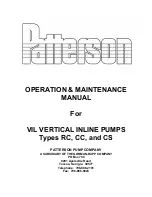
1. Using a micrometer or caliper,
measure from the outside of one
flange to the outside of the other at
intervals around the periphery of the
coupling. DO NOT rotate the
coupling.
2. Determine the maximum (B) and
minimum (C) dimensions.
3. If the difference between the
maximum and minimum exceeds the
Angular dimension in Chart 1 for
your sleeve size, loosen the motor
or pump and place thin metal shims
under the motor or pump feet until
the misalignment is corrected.
4. Torque down the motor or pump.
5. Recheck the parallel alignment
above.
CHART 1
If the parallel or angular misalignment
is great, this is an indication of base-
plate distortion and must be corrected
first, refer to 2C Leveling.
After all leveling and alignment
operations have been completed,
piping can begin. After the piping has
been completed, refer to 2E1 Piping
Alignment. Alignment of the unit must
be rechecked to make certain that no
piping strains are causing distortion.
After approximately two weeks of
operation, check the alignment again to
make sure that temperature changes,
piping strain, or foundation variations
have not caused misalignment. If
alignment has been maintained over
this period, the pump and motor can be
dowelled to the baseplate.
Page 504
Figure 2-1
feet so that strain and distortion will not
result when the mounting bolts are
tightened.
2C Leveling (Flexible Coupled
Pumps Only, Refer to Figure 2-1)
b. Adjust the shims until the baseplate
is not distorted.
5. Use a section of pipe to determine if
the inlet and discharge openings are
vertical and located properly.
6. Correct the positions, if necessary, by
adjusting the shims.
2D Alignment
Although flexible coupled pumps are
carefully aligned prior to crating and
shipping, it is very likely that strains
imposed during transit have altered the
alignment. Complete the following steps
after the unit has been placed on the
foundation and leveled.
To check the PARALLEL alignment:
(Refer to Figure 2-4)
To check the ANGULAR alignment:
(Refer to Figure 2-5)
COUPLING TYPES JE, J, S
MAX. RPM & ALLOWABLE MISALIGNMENT
SLEEVE
SIZE
MAXIMUM
RPM
PARALLEL
A
ANGULAR
B-C
3
9200
.010
.035
4
7600
.010
.043
5
7600
.015
.056
6
6000
.015
.070
If the unit is received with the pump and
motor mounted on the baseplate:
1. Place the unit in position.
2. Disconnect the coupling halves. Do
not reconnect until all alignment
procedures have been completed.
3. Support the baseplate on metal
shims or wedges having a small
taper. (Refer to Figure 2-2)
a. Place shims close to the founda-
tion bolts. (Refer to Figure 2-3)
Figure 2-2
Foundation
1/4"
Finished Grouting
3/4" to 1 1/2"
Allowance for
Grout
Dam
Baseplate
Grout
Leveling Wedges or Shims - Left in Place
Pipe Sleeve
Washer
Lug
Top of
Foundation Left
Rough - Clean
and Wet Down
Figure 2-3
b. Also place shims close to where
the greatest weight is located.
4. Check the baseplate for distortion:
a. Place a straightedge along the
baseplate to determine if it is
distorted.
Figure 2-4
A
1. Place a straightedge across the two
coupling flanges.
2. Measure the maximum offset (A),
Figure 2-4, at various points around
the periphery of the coupling. DO NOT
rotate the coupling.
3. If the maximum offset exceeds the
Parallel dimension in Chart 1 for your
sleeve size, loosen the motor or pump
and place thin metal shims under the
motor or pump feet until the offset is
corrected.
4. Torque down the motor or pump.
5. Recheck alignment.
Figure 2-5
B
C


































